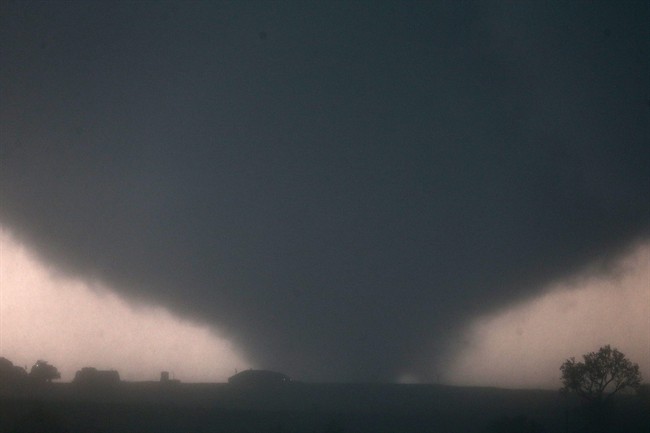TORONTO – What is it about tornadoes that continue to fascinate us?

Tornadoes, the violent, churning winds that wreak havoc across much of the United States each summer, are felt here at home, too.
According to Environment Canada, each year we experience an average of 80 tornadoes annually. However, they add, recent models show that the number is likely higher, as many parts of Canada are unpopulated, and many tornadoes go unseen.
Over time there has been a proliferation of some bad advice or so-called “facts” about this incredible force of nature. Here are a few myths, along with facts that could save your life.
Myth 1: Tornadoes always come from the west
Fact:
Tornadoes can move in any direction. Tornadoes generally travel in the direction a storm is moving, so if a storm is moving to the south, so will the tornado. Earlier this year, many tornado chasers in Oklahoma were taken off guard when a tornado in El Reno, which was moving west, looped back and began travelling north. Three professional chasers — Tim Samaras, his son Paul, as well as Tim’s chase partner Carl Young — were killed by the massive EF5 tornado. An amateur chaser was also killed.

Myth 2: You are safe from a tornado in your car
Fact:
As the photograph attached to the tweet below illustrates, a car cannot protect you from a tornado. A powerful EF5 tornado that struck El Reno on May 31 was responsible for destroying the car of The Weather Channel’s Mike Bettes (he claims he wasn’t trying to outrun it, but got caught in the change in direction). He and his team were lucky they weren’t killed. But even if you get caught in a weaker tornado, like an EF1, debris can fly through the windows and possibly kill you. Also, remember that you can’t outrun a tornado in your car.

Get breaking National news
So what’s the answer? Get out of the car and get to the lowest place you can go. Cover your head to protect yourself from debris.
Watch: Chasers get caught in the middle of a tornado
Myth 3: If you’re stuck in a car, the best place is to hide under an overpass
Fact:
Unfortunately, this myth became popular after a 1991 video circulated which showed a camera crew hiding under an overpass with several other frightened people. The tornado passed by them and nobody was killed or injured. But they were lucky.
In 1999, Kathleen Walton was killed after she sought refuge under an overpass while trying to protect her 11-year-old son. Unfortunately, this wasn’t an isolated incident: there are numerous other stories like this, as well as stories of people being seriously injured while hiding beneath an overpass.
The problem with overpasses is two-fold. One, the overpass can act as a catch basin for debris — large and small — and can lead to serious injuries (which means don’t park your car under one, either).
Secondly, the winds that are funneled through the narrow area could result in even higher wind speeds.
The National Weather Service has said that seeking shelter beneath an overpass is one of the worst places someone can go during a tornado and strongly suggest that people seek shelter outside of their vehicle in a ditch or other low-lying area.
Myth 4: To prevent your windows from being destroyed, you should open them
Fact:
“Nature will do that for you,” said Geoff Coulson, Warning Preparedness Meteorologist for Environment Canada.
Heading towards a window where debris shatter the glass and injure you is a bad idea. Instead, leave the windows alone, and seek shelter in the lowest part of your house. If you don’t have a basement or you’re in a highrise, put as many walls between you and the outside world — and stay away from windows. It’s not worth your life.
Myth 5: You can always see a tornado coming
Fact:
Definitely not true, and not only because tornadoes come at night.
Many tornadoes are “rain-wrapped” meaning that the rain around the core is so heavy that a tornado is hiding within the rain. Have you ever seen a picture of the tornado that struck Barrie on May 31,1985? No. That’s because it was a rain-wrapped tornado that no one saw coming. In fact, even Coulson said that he has never seen a photo of the deadly tornado.
As well, there are parts of Canada that experience high humidity which makes it even more difficult to spot a tornado.
Myth 6: You can tell how powerful a tornado is by how large it is
- ‘Really challenging issue’: Many B.C. communities still at high risk for flooding
- Mailing in your taxes? CRA says changes are coming amid push to digital
- Cold warnings across the Prairies forecast wind-chill temperatures near -45 C
- Canadian military member arrested, charged in foreign interference probe
Fact:
Some rope-like tornadoes can be EF4s while some wide wedge ones can be EF1.
The strength of tornadoes are measured by their wind speed, not their size. So a thin tornado could have intense winds whereas a wider one can have weak winds.
The only F5 tornado (the EF scale — Enhanced Fujita — was adopted by Canada this year) in Canada was captured by a chaser in 2007. The tornado passed through Elie, Manitoba. Fortunately, nobody was killed or injured. But if you watch the video below, you’ll see the development of the tornado from beginning to end and at no time does it take the familiar wedge shape of larger tornadoes.
Warning: Some strong language, viewer discretion advised
Myth 7: Cities can’t be hit by tornadoes
Fact:
Tornadoes can occur anywhere.
On July 31, 1987, the city of Edmonton was struck by a huge tornado. The F4 killed 27 people and is one of Canada’s deadliest tornadoes.
In the United States, tornadoes have hit Oklahoma City, Oklahoma; Fort Worth, Texas and Salt Lake City, Utah. It doesn’t matter what’s below: if the weather conditions are just right, a tornado can form anywhere, anytime.
So remember to keep safe and always…keep an eye on the sky!







Comments